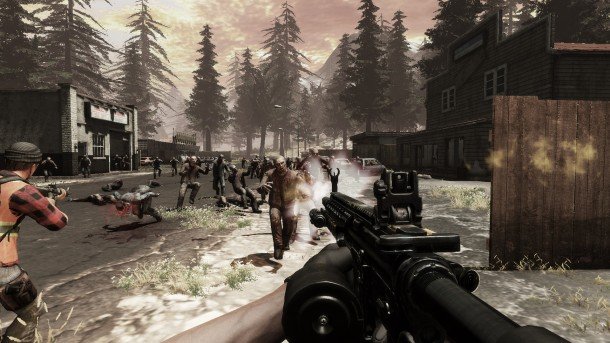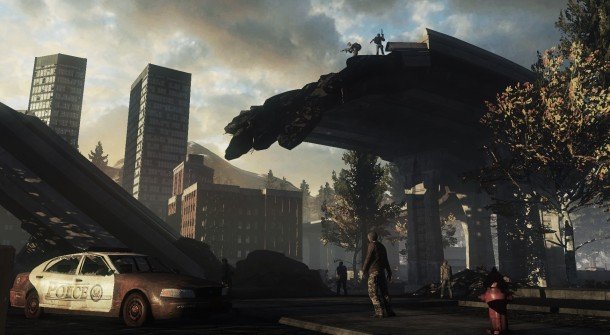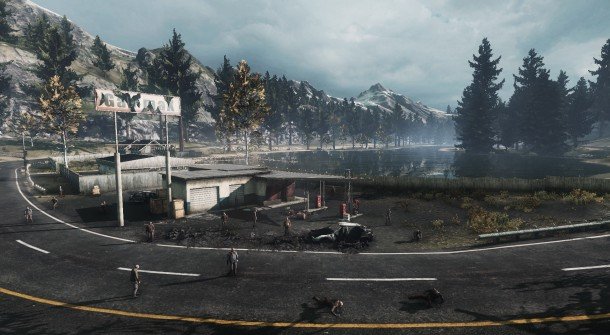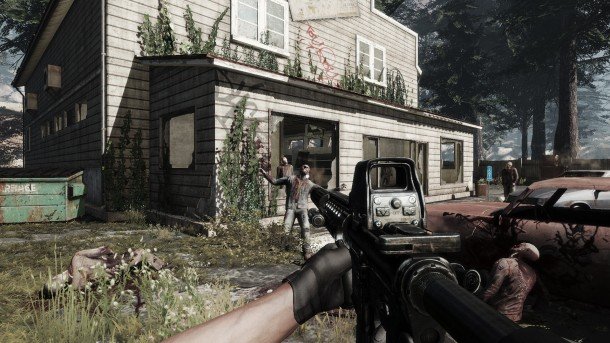The War Z preview

Sitting down to play The War Z for the first time feels like kicking the tires of an untrustworthy car. I feel the need to rattle the chassis, to jiggle handles, check for gum under the seat, listen for groans in the engine—to apply percussion with the expectation that some zombie muffler will fall loose.
Approaching a hands-on opportunity with this sort of diagnostic mindset is unusual. But The War Z is unusual; when the online survival game was suddenly announced in July, we reacted with mild hope and major skepticism. Makers Hammerpoint Interactive were promising a fuller-featured PvP/PvZ world than DayZ while cribbing concepts and mechanics from it, and it was promising you'd be able to play it this autumn—before the final version of DayZ is ready.
Half an hour with The War Z isn't long enough to suss every concern I have with the game, but my initial test drive of an alpha version was more encouraging than I thought it'd be.
I begin in a parking lot, one that looks like a welcome center for a national park. Conifers, oak, and birch shade knee-high grass. This is The War Z's “Colorado” map, the first of The War Z's settings. It's about 160km² (DayZ's Chernarus is 225km², or about 40 percent larger).
I start gunless, with this stuff in my inventory:
- Bandages
- A full, 375ml water bottle
- Antibiotics
- Instant oatmeal
- Flare
- Flashlight
And a map, though it's an always-owned item that lives on the M key. Executive Producer Sergey Titov, playing on another PC beside me, warps to my position. Titov throws a few gifts onto the pavement: a better backpack and a scoped rifle. He stipulates that guns, ammo, and (especially) attachments will be extremely rare in the final version of the game, making it sound like what I'm about to pick up off the ground is an apocalypse-king's bounty.
http://www.youtube.com/watch?v=OaaA5PQCcM8&feature=plcp
The biggest gaming news, reviews and hardware deals
Keep up to date with the most important stories and the best deals, as picked by the PC Gamer team.
Grabbing the loot is an absolute cinch: I look at it, hold E, and a line crawls clockwise around a circle to indicate that I'm picking it up. Feedback! Wait. Why am I happy about this? Right: because grabbing items in DayZ can feel like picking up sleeping cats with tweezers.
Once the gear is in my inventory, I can drag it around freely. Consumables like water and food can be right-clicked within my inventory to be spent. A row of the inventory is reserved for five or six active, “in-hand” items. Scrolling the mouse wheel fast-swaps between these from a set of Doom-style numbered inventory slots. Nothing nests in the backpack itself—all items I'm carrying share in the same visual space.
It's a modern, functional system, in other words. I'm impressed with this gear setup, and that feeling echos my other small moments of appreciation that emerge during my hands-on: The War Z simply benefits from being designed from the ground up to be the type of game it is. Adore DayZ as much as I do, The War Z lacks a few of the annoyances that arise naturally from the process of stuffing a PvE/PvP, persistent survival game into an intricate military sim.
http://www.youtube.com/watch?v=zkboXRI_M9U&feature=plcp
Titov leads me down a hill to a small town clinging to a two-lane road that curves around a lake. We glass zombies through binoculars at a safe distance. Some are still, some shamble, some stand on roofs. Titov right-clicks, centering his M4's red dot optics, and plugs away at a few closer undead. His gun fires with the recoil and responsiveness you'd expect in Battlefield 3: bullet drop is modeled, but not all of Newton's laws are along for the ride. There's a weird, circular tracer that zips through the air with every shot we fire—an effect I hope is only in place for debugging purposes.
Zeds start to creep in from our back and side (partly because zombie vocalizations and footstep effects haven't been baked into the build yet), and we flee through an alley formed by a wooden fence and a church. I mash a zed with my flashlight four or five times until it falls over. At this alpha stage, the zombies' animations and movement balancing is incomplete. Undead streamed in at a consistent pace—about 80 percent of our sprinting speed—that made them easy to dispatch. Right now, they lack the erratic, bobbing gait and head movement that makes kill shots in DayZ so satisfyingly difficult. Titov says faster zombies will be added later on.
We cross open pavement, and trip a few “sleeper” zombies. These undead lie dormant on the ground, but rise when they notice you nearby. We make it across the parking lot okay, then hop the counter of a post office building to check for more gear. I loot painkillers, a military helmet, bandages, and a Mossberg shotgun. The gear is actually resting on shelves. This isn't some mindblowing innovation, but it's a tiny detail that, again, reinforces that The War Z will at least benefit from being designed from scratch to be a survival game.

Going downtown
Titov teleports us to another area of the Colorado map. We're on a highway raised on concrete stilts, overlooking a relatively dense downtown made up of office and residential buildings. I point at the tallest one and ask if we can go in. Titov obliges. We drop down a broken segment of the freeway, taking fall damage as we do, and hop a waist-high wall of sandbags outside the door.
We head up to the fourth floor; the roof of the building is closed off, but Titov says the door blocking us from entering is only in the alpha build temporarily. I start trying to poke holes in what I'm seeing. Is occupying a structure for a longer period of time something that's supported by the game? Titov says yes: item storage is persistent, so if clanmates want to hunker up in a multi-story office building like this one, they can barricade it, use it as a giant stash, and try to guard it from other players.
How is The War Z addressing death-escaping loopholes like slamming Alt + F4 at the first sign of danger? Titov demonstrates: when you exit the game, you have to wait for a 10-second timer to expire. This is a really simple solution; I'd prefer a system that's able to gauge if you're engaged in combat, and prevents logging out when that's the case. But it's better than nothing.

What measures will be in place to prevent item duplication and hacking? Titov mentions his experience dealing with cheaters in his other project, War Inc. “For War Z, since it's a much slower-paced game, we've been able to do lots of the logic server-side. On War Inc., we have to do lots of things on the client, just to keep up the fast-paced nature of the game, to keep the lag as low as possible and things like that. For War Z, that's not a requirement. We'll see. Obviously once the game is released, we'll probably see new cheats pop up. Hopefully it won't be as bad as it was when we launched War Inc. on Steam. The first week was okay, but the second week we had cheating popping up. We spent a month of like, fierce fighting, basically changing stuff on a daily basis. After a month we killed probably 90 percent of the cheaters.”
From my first brush with it, The War Z feels like familiar ingredients mixed by a different chef. My impression that it'd be a more accessible take on DayZ was affirmed by the weapon handling, Battlefield-like movement speed, and seemingly streamlined detection mechanics. The act of shooting isn't as arcadey as, say, Borderlands 2—the ironsights on an M4 I picked up, for example, had parallax between the front of the barrel and where my eye meets the gun. But The War Z doesn't seem to have DayZ's spirit as a simulation—it's not driven by fidelity, real-world ballistics, or a feeling that you're in a space modeled after reality. Details like freelook are absent. When you're about to deploy a barricade item (like a set of wooden planks), the ghost-outline of it floats in front of you weightlessly—a single click deploys it instantly into the world.

And yet, it's possible that The War Z could still support the kinds of strange and serendipitous player interactions DayZ has become known for. For one, it lacks some of the jankiness inherent to Arma's engine tech. Corpses ragdoll. Buildings have more than two floors. Swapping weapon attachments—a system straight out of Crysis 2—is effortless. I'm also interested in some of its systems: player authored questing, especially. I'm looking forward to seeing how formalizing bounty-setting and other such systems impacts emergence and the feeling of player-owned stories.
I'm intrigued that The War Z's offering private, rentable instances too. In addition to larger, full-map servers that The War Z will make available for rent, the game will make smaller instances available, that individual players can purchase for a few dollars a month. These “Strongholds” almost function as player or clan housing: templated settings like a cabin in the woods, a farm, a small town on a cliffside, or a trainyard that you can invite other players to. Titov also mentions to me that “you'll have the option to “lock” certain locations with keypad lock, so only people who know the code can get inside, thus dividing map space into 'public' and 'private' portions.” I love the idea of learning someone's secret code to infiltrate these areas.
So, my skepticism about The War Z is swinging a bit more towards curiosity, I guess. I need to spend much more time with it (and on a populated server) before I can make a better-supported conclusion about what it's going to feel like to play at launch. Right now, it presents a handful of good antidotes to some of DayZ's simple issues. But it's also rough around the edges: the zombies are unfinished and not very intimidating, VOIP isn't in yet, and presentation elements like animations related to the use of medical and food items are missing. I can't judge still-unintegrated systems like bounty-setting and Strongholds until I see them. The alpha build didn't reassure me about how dangerous The War Z will be, either—I never felt the need to be careful, but then again, as a closed alpha, it's understandably vacant. Expect a more thorough evaluation of The War Z once we're able to spend more than half an hour in it.

Evan's a hardcore FPS enthusiast who joined PC Gamer in 2008. After an era spent publishing reviews, news, and cover features, he now oversees editorial operations for PC Gamer worldwide, including setting policy, training, and editing stories written by the wider team. His most-played FPSes are CS:GO, Team Fortress 2, Team Fortress Classic, Rainbow Six Siege, and Arma 2. His first multiplayer FPS was Quake 2, played on serial LAN in his uncle's basement, the ideal conditions for instilling a lifelong fondness for fragging. Evan also leads production of the PC Gaming Show, the annual E3 showcase event dedicated to PC gaming.

